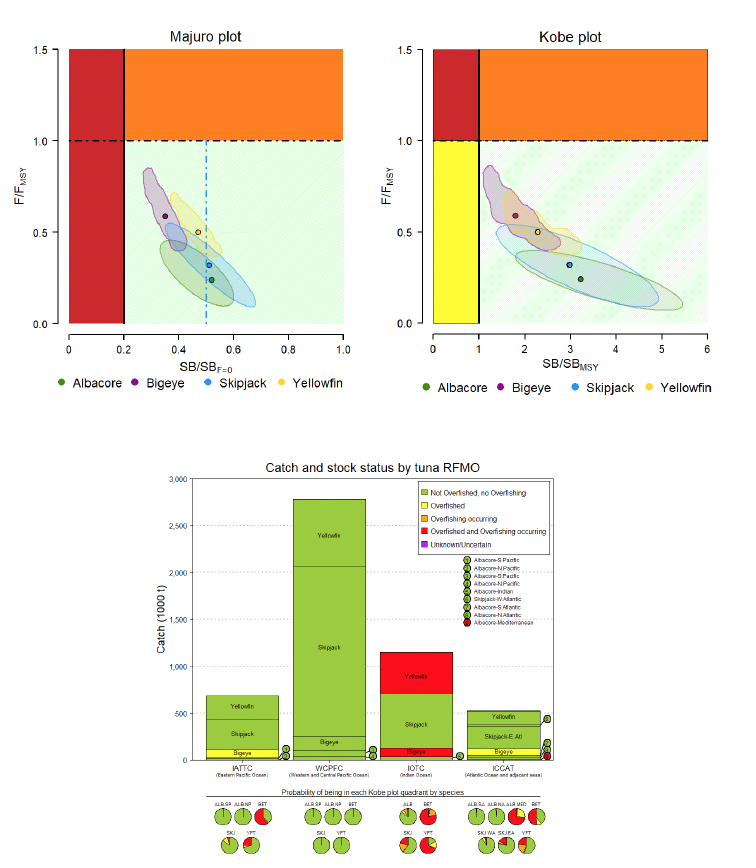It is the time of year when SPC’s flagship tuna publication, “The Western and Central Pacific Tuna Fishery: 2022 Overview and Status of Stocks”, comes out. They are the data collection and science providers of the WCPFC.
The publication always has well-crafted graphs and tables, with some information immediately apparent and others requiring closer reading.
The news still talks about the collapse of tuna fisheries in the Pacific, that the (name your geopolitical nemesis, i.e China, the US, Korea, Japan, EU, etc) are taking all the fish, that the regional management organisations are secret, that we need ecolabels to know if fisheries are sustainable, and so on…
So…Do you want to rely on the multimillion-dollar spin industry for information, or do you prefer to read a document that links all the scientific evidence supporting their claims? This document includes an analysis of the fishery by species and fleet type, as well as the impact of climate change and much more.”
Like most things in life, there is good and bad news. Some things are going well, while others are not. However, if you look closely, you can see beyond the surface.
So, if you're reading this blog, it's probably because you're interested in tuna fisheries in the region. This publication is essential reading for any informed discussion.
What are the things I rescue?
The Good
The main tuna stocks are not overfished, overfishing is not occurring, and we need to keep working hard to make sure it will not occur.
The Bad
Over the past decade, five species of billfish under the WCPFC-CA have been formally assessed. The Southwest Pacific swordfish and Southwest Pacific striped marlin were last assessed in 2021 and 2019, respectively, by SPC. On the other hand, the North Pacific swordfish (scheduled for assessment in 2023), North Pacific striped marlin (assessed in 2019), and blue marlin (assessed in 2021) were assessed by ISC. The stock status of these species is determined using the Kobe plot approach, which compares the overfished status relative to spawning stock size at MSY. However, there is considerable uncertainty in the estimates of F/FMSY and SB/SBMSY for all five species. Based on the assessment model grid medians, it is likely that the Southwest Pacific striped marlin and North Pacific striped marlin are overfished, while overfishing is also observed for North Pacific swordfish.
Similar to billfish, the bycatch of sharks (which includes both sharks and rays) is much higher in the longline fishery, ranging from 1.5 to 2.0 million individuals, compared to the purse seine fishery, which ranges from 50,000 to 100,000 individuals. The catch of sharks is generally associated with the fishery, although the numbers have been similar in recent years. A detailed species composition analysis is needed better to understand the impact of fishing on shark populations.
The status of silky and oceanic whitetip sharks is of particular concern, as assessments have shown that these stocks are subject to overfishing and, in the case of oceanic whitetip, is severely overfished.
The worrying future
The projected changes in abundance and redistribution of these tuna associated with climate change could have significant implications for the economic development of Pacific Island countries and territories and the management of tuna resources at the ocean basin scale. In particular, larger proportions of the catch of each species are increasingly expected to be made in international waters.
Bad for fishers
Talked about this before… You see fishing effort in fleet sizes and number of hooks fished (bottom), for the longline fishery in the WCPFC.
In 1993/4 when I was fishing these waters, it was the heyday of LL in the WCPO, peaking into 5000 vessels. Today as you can see, there is only 1/3 of that fleet left (1600), yet they are soaking almost twice the number of hooks. How can that be possible? Deck and gear setting technology are almost the same… response: overworking crew.. workload has been duplicated.
Since then, transhipment at sea has exploded (as I reported before), which allows the vessels to stay fishing longer and, sadly, massively increases the crew's workload.




